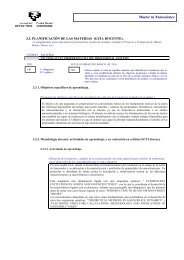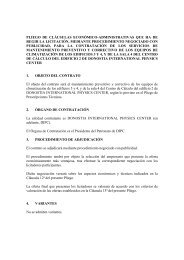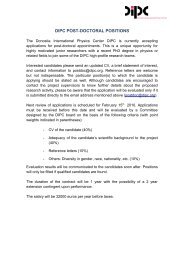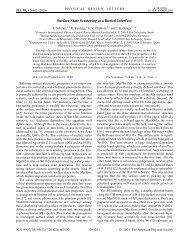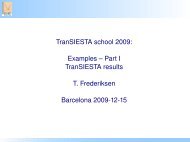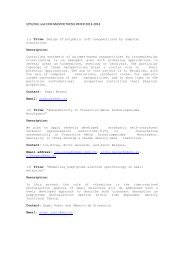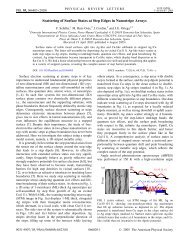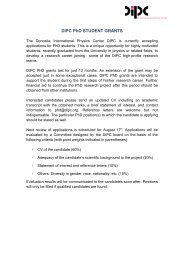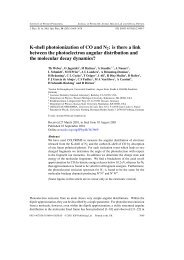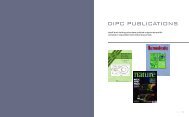Complete report - Donostia International Physics Center - Euskal ...
Complete report - Donostia International Physics Center - Euskal ...
Complete report - Donostia International Physics Center - Euskal ...
Create successful ePaper yourself
Turn your PDF publications into a flip-book with our unique Google optimized e-Paper software.
2011 DIPC Highlight<br />
Anharmonic stabilization of<br />
the high-pressure simple cubic<br />
phase of calcium<br />
I. Errea, B. Rousseau, and A. Bergara<br />
Physical Review Letters 106, 165501 (2011)<br />
The understanding of how the atoms vibrate in a solid is crucial to comprehend many of its physical<br />
properties. As an example we can cite thermal transport properties, specific heats, Raman and neutron<br />
diffraction spectra and the very appealing superconductivity. These atomic vibrations are generally explained<br />
in terms of phonons: the quantum of the atomic oscillations. Phonons are calculated in regular<br />
basis applying the harmonic approximation, that is, considering exclusively the behavior of the ionic potential<br />
in the vicinity of the equilibrium position. However, there are cases in which the behavior close to<br />
the equilibrium position does not describe properly the dynamical behavior of the solid and leads to wrong<br />
results. For example, there are experimentally confirmed structures of solids that display imaginary<br />
phonons in ab initio calculations suggesting that the crystal structure is unstable and cannot be realized<br />
experimentally. In order to solve this apparent contradiction the behavior of the atoms farther from equilibrium<br />
needs to be taken into account, that is, anharmonicity cannot be neglected in these systems.<br />
Figure 1: Schematic representation<br />
of how anharmonicity<br />
can stabilize the atomic vibrations<br />
and how the harmonic<br />
approximation can yield to a<br />
wrong interpretation.<br />
The high-pressure simple cubic phase of calcium is a clear example of the latter. Although phonon calculations<br />
based on the harmonic approximation predict that this phase is unstable, many experiments confirm<br />
that this phase is stable and exists in nature. Moreover, calcium starts to superconduct in this simple<br />
cubic phase and becomes the element with the highest superconducting transition temperature (Tc) reaching<br />
29 K above 200 GPa in another phase. Thus, the emergence of superconductivity in Ca cannot be understood<br />
within the harmonic approximation since the electron-phonon interaction cannot be calculated<br />
with imaginary phonons.<br />
Considering that in the harmonic result the ground state energy is not bounded, the anharmonicity in simple<br />
cubic Ca requires a variational approach and suggests the application of the self-consistent harmonic<br />
approximation (SCHA). The SCHA assumes that the best phonons are those that minimize the free energy<br />
of the system. In order to apply the SCHA an arbitrary harmonic term is included and subtracted to the<br />
potential. Then, the free energy is minimized with respect to this arbitrary harmonic term. Finally, the frequencies<br />
that diagonalize the arbitrary harmonic part are the anharmonic frequencies. In order to do so,<br />
the anharmonic coefficients need to be known. In this work performed at the DIPC, this procedure has<br />
been applied for the first time using rigorous ab initio calculations.<br />
The method that has been developed is able to predict that the simple cubic phase of calcium is stabilized<br />
by strong anharmonic effects. Moreover, the anharmonic phonon dispersion that has been obtained has<br />
made possible the calculation of the electron-phonon coupling and predict the superconducting properties<br />
of this system. The calculated value of Tc is in sharp agreement with recent experiments. This strongly<br />
supports the validity of the method used.<br />
The SCHA is a theory that might be used to understand many systems were anharmonicity plays a crucial<br />
role such as ferroelectrics, systems with charge-density waves and hydrides. These results shows that the<br />
SCHA is an appropriate framework to tackle all these type of systems within ab initio calculations, something<br />
not possible so far.<br />
Figure 2: Harmonic phonon spectra and renormalized anharmonic phonon spectra at 0 and 300 K of simple<br />
cubic Ca at 50 GPa. The anharmonic results for the integrated electron-phonon coupling parameter, the Eliashberg<br />
function and the phonon density of states (PDOS) are shown as well.<br />
62 DIPC 10/11<br />
DIPC 10/11 63



